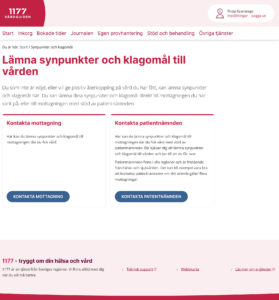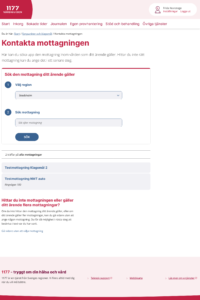Uppdrag
Utvärdera och förbättra Synpunkter och klagomål, 1177:s nationella e-tjänst för att framföra.
Tidsram: åtta veckor (2022).
Team: Amin Amini, Cecilia Parkert och Tine Persson.
Mina arbetsuppgifter:
- User research
- Heuristisk utvärdering
- Användningstester
- Wireframes
- Prototypframställning i Figma
Designprocess
En heuristisk utvärdering genomfördes för att identifiera användarupplevelseproblem med Synpunkter och klagomål.
Därefter utfördes användningstester där sex deltagare använde tjänsten för att lämna fiktiva klagomål på vården. Flera wireframes och prototyper skapades för att åtgärda de identifierade problemen med Synpunkter och klagomål.
Resultat
11 större designlösningar skapades för att förbättra användarupplevelsen och tillgängligheten hos Synpunkter och klagomål. Dessa lösningar övervägs för närvarande för vidare implementering.

En ny 1177 e-tjänst för att lämna klagomål inom hälso- och sjukvården
Inera driver 1177, Sveriges nationella plattform för hälsoinformation och digitala tjänster. 1177 erbjuder miljontals medborgare hälsovårdstjänster som att boka tider, få digitala behandlingar och läsa sina medicinska journaler.
1177 lanserade Synpunkter och klagomål år 2022 och e-tjänsten ska kunna användas av alla medborgare i landet för att lämna klagomål om den vård de har erhållit. När ett klagomål har lämnats in använder medborgarna tjänsten för att direkt kommunicera med den relevanta kliniken eller den regionala patientnämnden.
Synpunkter och klagomål är en avgörande tjänst eftersom det är en av de viktigaste kanalerna genom vilka medborgare kan göra sina röster hörda angående allvarliga hälsofrågor och, i slutändan, få rätt vård.
Uppdraget
Mitt team bestående av tre designers fick i uppdrag av Inera att arbeta med 1177:s nyligen lanserade e-tjänst Synpunkter och klagomål, och mer specifikt:
- Utvärdera hur tjänsten fungerar ur ett användarperspektiv på en stationär dator
- Identifiera användbarhets- och UX-problem
- Föreslå förbättringar till tjänsten
Översikt av användargränssnittet för Synpunkter och klagomål
När medborgarna har loggat in på 1177 och valt Synpunkter och klagomål på startsidan använder de tjänsten på följande sätt:
- De väljer om de vill kontakta den berörda klinikens sjukvård direkt eller få hjälp från sin regionala patientnämnd.
- De väljer den faktiska kliniken som de vill lämna ett klagomål mot.
- De beskriver sitt ärende genom att fylla i formulär.
- När klagomålet har skickats in visas bekräftelsesidan. Nya meddelanden från kliniken dyker upp i användarens inkorg på 1177 och användaren svarar också genom inkorgen.
Processen
Här är en översikt över hur vi gick tillväga med att utvärdera och omdesigna Synpunkter och klagomål:
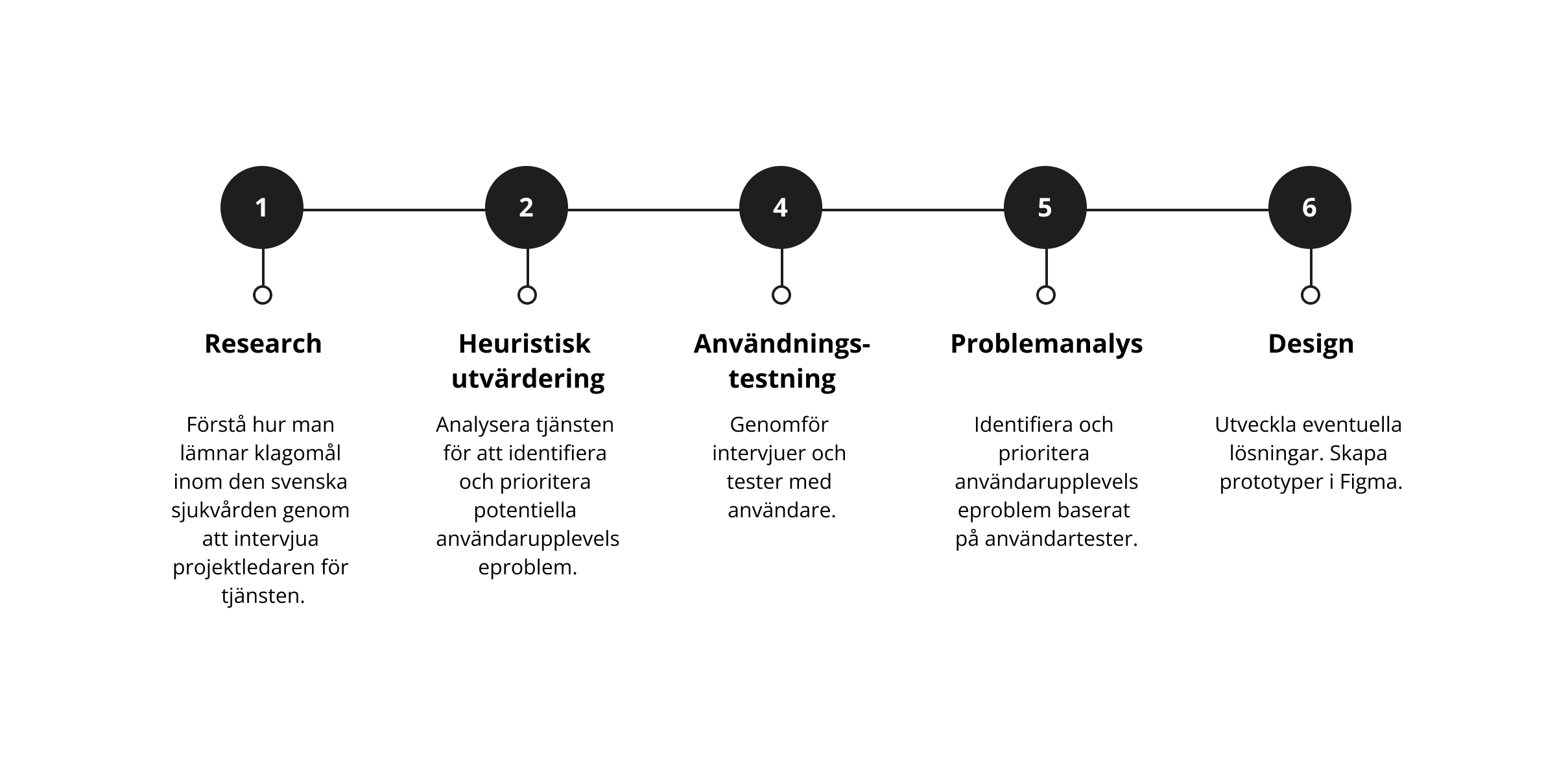
Användningstesterna var avgörande för att upptäcka problem med Synpunkter och klagomål ur ett UX-perspektiv. Våra sex testdeltagare var mellan 26 och 75 år med lika många män som kvinnor. Genom att rekrytera en äldre person med låg datorvana och en nysvensk med svenska som andra språk försökte vi identifiera behoven hos särskilt sårbara grupper i samhället.
Omdesign av e-tjänsten Synpunkter och klagomål
Här är de viktigaste designförslagen som teamet skapade för 1177:s e-tjänst Synpunkter och klagomål. Förslagen baseras på resultaten av den heuristiska utvärderingen och användningstesterna.
En kommentar om omdesignen
Omdesignen på denna sida är varken implementerade på 1177 eller godkända av Inera, ägaren till 1177. De utgör helt enkelt designförslag skapade av designteamet.
Tillägg av en onboarding-upplevelse
Det var utmanande för testdeltagarna att förstå det underliggande hälso- och sjukvårdssystemet och klagomålsprocessen som tjänsten är utformad för att stödja. Designteamet föreslår en onboarding som förklarar processen på ett tydligt och koncist sätt samtidigt som nyfikna medborgare ges möjlighet att lära sig mer om tjänsten.

Förenkla valet av mottagare för klagomål
I början av användningen tjänsten måste användaren bestämma vem som ska ta emot det klagomål de lämnar in: kliniken ansvarig för klagomålet eller regionala patientnämnden.

Vår forskning indikerar att användarna hade svårt att fatta informerade beslut eftersom skillnaden mellan de två alternativen var oklar.
I en av flera omdesignförslag skapade vi en guide som skulle föreslå en mottagare av synpunkter baserat på val som är viktiga för användaren.
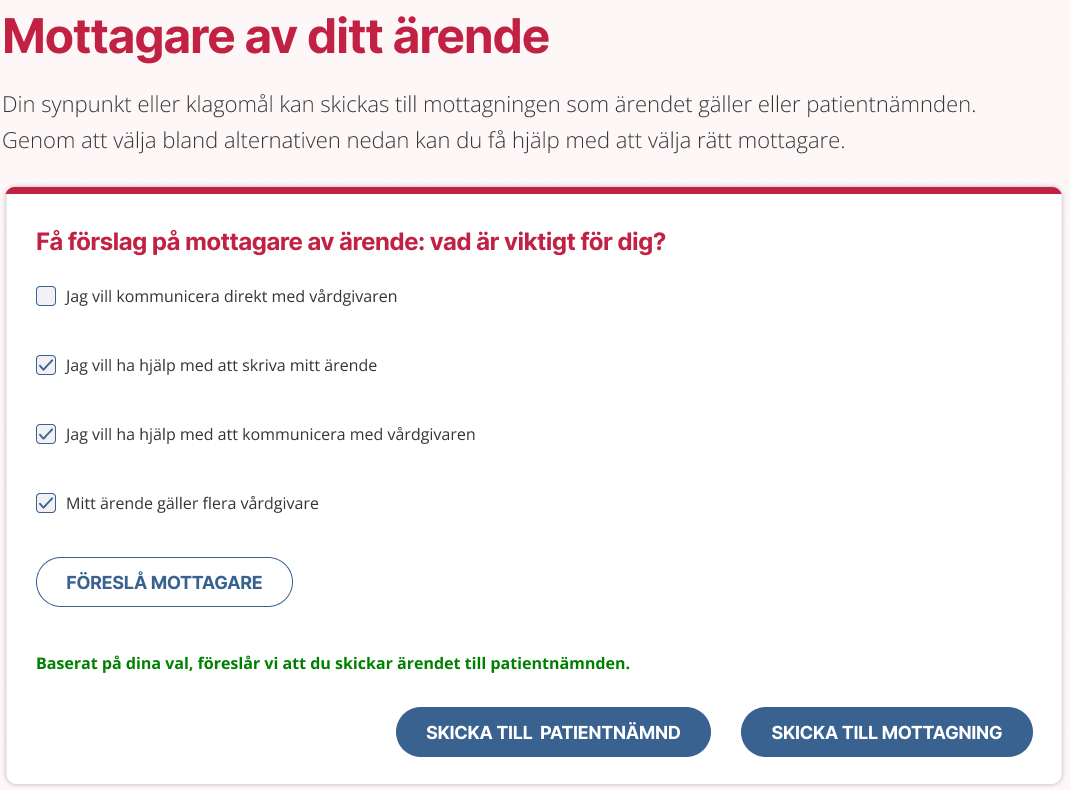
Vänta, går det att välja det?!
Att söka efter och välja den ansvariga vårdkliniken är ett avgörande val som människor måste göra när de använder Synpunkter och klagomål. Under våra användartester märkte vi att när användarna väl hade hittat kliniken, så var det faktiska valet svårt på grund av låg användarvänlighet. Detta är särskilt problematiskt eftersom det innebär att användaren inte kan fortsätta använda tjänsten:
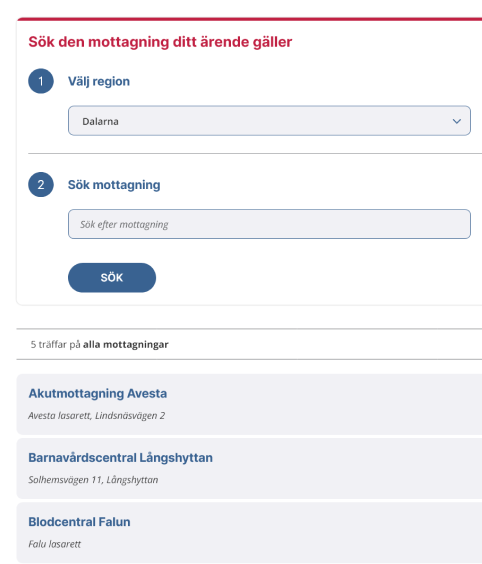
Vår omdesign fokuserar helt enkelt på förbättrad användbarhet när en person väljer en klinik:

Erfarenhet och lärdomar
Överlämning av design: Designteamets resultat och omdesign presenterades för nyckelpersoner på Inera, vilka reagerade mycket positivt på problemanalysen och designförslagen. En del av designförslagen övervägdes för implementering. Designteamet betraktar detta som en framgång eftersom 1177 och dess tjänster är en del av en kritisk och komplex plattform där förändringar måste göras med stor omsorg.
Design med fokus på desktop: Designteamet utförde inga användartester på mobil eftersom projektomfattningen var begränsad till desktop av Inera, baserat på antagandet att användning av tjänsten huvudsakligen skulle ske på desktop på grund av den komplexa karaktären av att lämna klagomål inom sjukvården. Insikter från användartesterna leder oss dock att tro att den mobila versionen av Synpunkter och klagomål också behöver utvärderas.
Användarintegritet och testning: På grund av integritetslagstiftning och -regelverk baserades användartesterna på ett fiktivt fall med testkonton, vilket uppenbarligen påverkade användarbeteendet och svar i intervjuerna om Synpunkter och klagomål. Att genomföra framtida användartester med verkliga medborgare, fall och interaktioner mellan patient och vårdpersonal skulle avslöja mer komplexa frågor och behov.
Inkluderande design: Att ha representation från marginaliserade grupper är särskilt viktigt för kritisk infrastruktur som 1177. Designteamet rekryterade exempelvis flera personer som representerar marginaliserade grupper, såsom äldre eller personer med svenska som andra språk. Utmaningen är hur man balanserar behoven hos många marginaliserade grupper med företagsrealiteter som tidsfrister och begränsade resurser tillgängliga för oss. I efterhand borde designteamet ha haft fler deltagare än sex för användartestningen, men vår tidsfrist gjorde detta svårt att genomföra.


